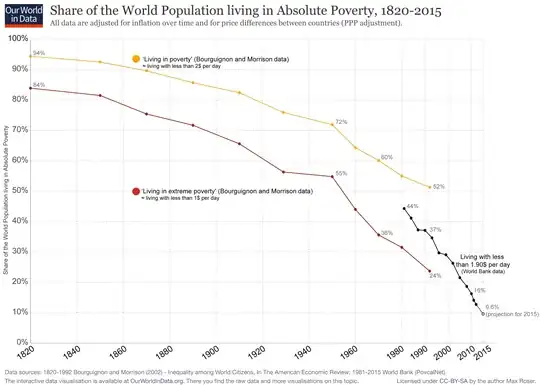No, but it is true that a very large number of people are in "extreme poverty", as defined by the World Bank. One recent estimate (source) is that
in 2015, there were 702 m people living on less than $1.90 per day (at 2011 prices).

The quote from that webpage ("nearly half the world’s population, 2.8 billion people, survive on less than $2 a day") was probably true when written, but is now probably outdated for two reasons (it doesn't give sources, so I can only guess why it's outdated):
- Inflation. (My guess is that they were using 2005 prices. The current threshold uses 2011 prices.)
- More importantly: Progress in reducing poverty. Rapid progress continues to be made in reducing poverty. (My guess is that the webpage was using figures circa 2010.)
A frequent misconception/myth (expressed for example by @Tanmoy in the comments) goes something like this:
Myth #1: "stuff is much cheaper in poorer countries; therefore $$1.90 can go a longer way in poorer countries."
This is wrong. When such figures as "702 million people survive on less than $1.90 per day" are quoted, they really DO mean that the world's most miserable 702 m people have to survive as if they had less than $1.90 a day, while facing the average USA prices!
This is shocking and unbelievable for those from countries with no historical experience of extreme poverty (e.g. the US). But it is sadly true.
How do these 702 m people survive on less than $1.90 per day at USA prices? Well, many of them don't. And those who do, manage to survive, only very barely and very miserably.
Another frequent myth that has cropped up a couple of times in the comments above (@jwenting and @PaulJohnson):
Myth #2: "The $1.90/day figure overlooks non-monetary transactions (e.g. barter) and self-produced, self-consumed goods. ...
"... For example, a farmer who owns a huge farm and lots of livestock, simply survives off his produce, never engages in any monetary transactions with anyone, will be counted by the World Bank as having an income of $0/day and therefore be counted as 'extremely poor'. But he may actually be extremely well-off and have all that he needs."
This is also wrong. Unfortunately and again shockingly, the $1.90/day figure already accounts for all such non-monetary transactions and also all self-produced, self-consumed goods.
So the farmer with the huge farm will also have a (correspondingly-huge) monetary value imputed to his annual agricultural produce, and he will NOT show up as having $0/year in the poverty count. Instead, he will show up as a reasonably affluent man.
Bottom line: The $1.90/day figure is unbelievable for most people living in rich countries. But that's really what it means. Surviving on $1.90 per person per day, in a place where the prices of goods and services are the same as in Averagetown, USA.
Evolution of the extreme poverty threshold:
- $1 (or $1.01) per day at 1985 prices.
- $1.08 per day at 1993 prices.
- $1.25 per day at 2005 prices.
- $1.90 per day at 2011 prices. (This last update was officially announced in October 2015.)
(One source for the above figures.)
Note that at least conceptually, the extreme poverty threshold is supposed to have stayed the same in real terms. That is, $1.90 per day at 2011 prices is supposed to be equivalent to $1 per day at 1985 prices (in real terms). Once again, it must be stressed that, shockingly enough, these are USA prices.
Here's a YouTube video that discusses these issues and in particular dispels the myths and misconceptions mentioned above.

